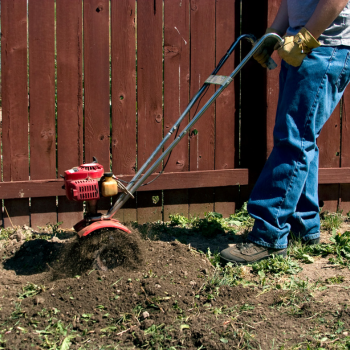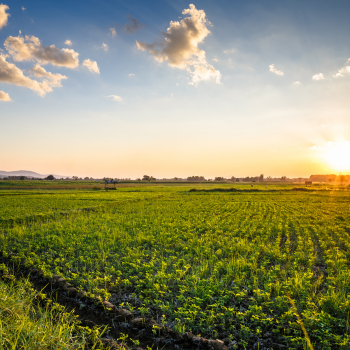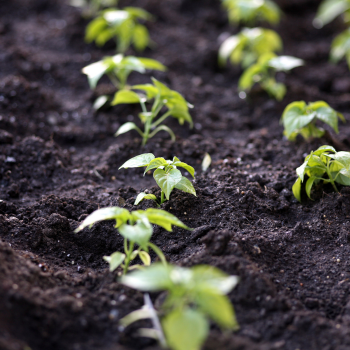Soil health is defined as the “ability of soil to function as a vital living ecosystem”. Sounds simple enough, but our entire food system has been built around looking at soil as a storage medium for chemical nutrients. Having researched organic (the true meaning of organic originated as recognizing the living, biological component of soil) methods of growing food for over thirty years, it is inspiring to see the science catching up to what organic pioneers have always known, that biology matters.
Soil function is the ability of soil to store and cycle nutrients and water. Approximately 85-90% of nutrient exchange (nutrient cycle) is through biology and biology drives the formation of soil structure increasing water holding capacity (water cycle). Without a diverse living component in soil it cannot function properly.
Poor soil function leads to lower nutrient levels in our food, declining quality of our water, and a general decline in the health of our environment, which includes us as people. The good news is, we are gaining a better understanding of what it takes to build soil health. There are several soil health “principles” we can follow to get us there. These principals act as a guide to create the conditions in our soil that allow it to properly function. I will be sharing these principals, how they are changing large scale agriculture, and how you can implement them in your own backyard.

In the publication Conquest of the Land Through 7000 Years , Dr. Lowedermilk, on the heels of the 1930’s dust bowl, wrote how civilizations have thrived or failed based on how they treat the soil.
Done poorly agriculture causes damage, divisiveness and scarcity. Done well agriculture heals our land, our water and our communities.
1. Minimize Disturbance
A few years ago we had a storm hit our home. I’m not sure if it was a full blown tornado, but I woke at 3 AM to the “train” sound howling outside the window. We never made it to the basement before it was over. The next day all you could see outside our window was green. We lost several large trees and had to replace the roof on our house and garage. With some help from our kids and a good roofing contractor, within a month or two things were back to normal. That’s what it’s like for the microorganisms living in your soil every time the soil is plowed or tilled. There home is being destroyed and needs to be rebuilt.

Minimizing disturbance is the first key to soil health. Tilling and plowing break soil aggregates into smaller particles reducing pore space and reducing the soil organisms ability to move in the soil, It also releases and depletes organic matter, an important component of a healthy soil and contributes to the growing climate issue.
Applying synthetic fertilizers and pesticides also disrupt the soil food web, often in ways we don’t fully understand. Minimizing these practices helps set the stage for a diverse and healthy soil community.
Large scale farmers often look to find a balance between herbicides and tillage. Termination of an existing stand is the biggest issue. One valuable tool for this is a cover crop crimper, which if used at the right time of maturity, on the correct crop, will lay it flat and crimp it every 4-6 inches and effectively kill it. They have good luck with this on annual rye, often drilling soybeans into the standing rye when it first starts to flower, then crimping it down just as the beans start to germinate. Planting cover crops that die or using livestock to graze a crop back are other ways to terminate an existing stand without herbicides. That said, some farmers suggest and data supports that herbicides may be less damaging to soil life than tillage.
On a smaller scale I’ve found that raised beds provide a viable no-till option. If you stay on top of weeding and keep the beds well mulched, over time weeds become manageable. Controlling grasses with rhizome roots is important. Shallow hoeing with a sharp tool is light and effective work. On a larger scale I try to keep tilling to once every four years or so. Establish a crop rotation that builds on previous years.
Example Rotation;
- Year one; strip till potatoes. In the fall plant garlic where potatoes were dug.
- Year two; garlic
- Year three; brassica, onion, celery companion planting
- Year four; Three (four?) sisters, corn, beans, squash, (sunflowers)
- Years five and six – perennial forage
Keep well mulched throughout the first four years. Chop and drop weeds that haven’t gone to seed with weed whip or hand pull large weeds. Frost seed (on frozen ground with 2” or more of snow) a diverse mix of legumes and grasses going into year five.
2. Armor the Soil
I was listening to a presentation by Joshua Dukart at the Northern Plains Sustainable Agriculture conference. Mr. Dukart is a Certified Educator of Holistic Management with the Burleigh County Soil Conservation District in North Dakota, one of the first regions of the country to adopt soil health principles. He was telling the story of how one day the then District manager, Jay Fuhrer, came in from the field and started ranting, “they call it crop residue, trash, and litter. It’s way too important for names like these,” he claimed as he went to his office and slammed the door. He emerged a few minutes later, pounded his fist on the table “We’re calling it armor, it’s that important” he declared. As a past SWCD employee I understood the passion for conservation and could only imagine the conversations these pioneers of soil health had… To be a fly on the wall.

Soil organisms are living beings and need favorable conditions to survive and thrive. Soil without armor leaves it open to erosion, large temperature extremes, and loss of moisture to evaporation. Soil covered with living plants can be as much as sixty degrees cooler than bare soil on a hot day. Raindrops hitting bare soil dis-lodges the finest soil particles, plugs soil pores, and causes soil crusting which prevents water infiltration and inhibits seed germination. Mulch and living plants preserve soil moisture and protect soil life and structure.
Cover crops are increasingly being used by farmers to protect and armor the soil. Some regions of the country are seeing cover crops utilized on upwards of 30% of cropland. Innovative farmers are modifying equipment to interseed cover crops and new opportunities are being developed around cover crop seed production. Moving to perennial forage as part of the rotation, or to perennial pasture as the optimum soil armor.
One method for gardeners to keep their soil armored is a deep mulch method. Hand dug beds, six inches tall and 3-4 feet wide, are dug and covered with several inches of straw or old hay. To plant, the mulch is moved to the side or on the walkways. Beds are top dressed with compost and soil amendments in the fall and remulched. Every two or three years the walkways are redug, placing the soil from the walkways on top of the raised beds and the beds raked level, then covered with another generous layer of mulch. Diverse cover crop mixes made up of annual species or those that freeze out over winter are another way to keep small garden spaces protected. If planted late enough in the season they don’t have a chance to go to seed and become a weed issue, though with most cover crop species I haven’t found this to be an issue. I seed the large seeded species first and lightly rake or hoe them in, then seed the smaller seed on top. The larger seed germinates first and provides the microclimate for the smaller seed to germinate. “Chop and drop” is a common method of weed control, where weeds are cut before going to seed and left in the garden. And some species, especially those with hollow stems at maturity can just be walked down, as a simple form of crimping.
Example annual cover crop mix (seeded between Sept 1- 15). Percentage by weight.
30 % oats or barley, 30% buckwheat or sunhemp, 30% common vetch or field peas, 5-10% field turnips or radish.
3. Keep Living Roots in the Soil (AKA: Plant Snot)
In the early 1990’s Dr. Elaine Ingham helped the Natural Resource Conservation Service (NRCS) publish the Soil Biology Primer as an “introduction to the living component of soil”. Dr. Ingham and this little booklet were driving forces behind the soil health initiative of the NRCS. I was able to hear her speak at the MN Organic conference several years ago. She explained the life cycle of the soil as this. Plants exude a snot like substance from their roots as they grow, about 30% of their total photosynthate. This exudate, or “plant snot” serves as a primary food source for microorganisms in the soil, mostly specific bacteria that live close to the root of the plant, the rhizosphere. The organisms that feed on this substance are in turn eaten by larger bugs, She went on to explain. And when those organisms die or defecate, they provide minerals and nutrients in the right form and balance that the plant needs to grow. Plants feed the soil life and the soil life in turn feeds the plants.

Keeping living roots in the soil helps ensure a steady supply of this plant exudate to feed the microbiome in the soil. Living roots also support mycorhize fungi, a type of fungus that attaches to plant roots and form a symbiotic relationship with the plant. The plant feeds the fungus, and the fungus converts nutrients to a usable form and feeds them to the plant. Without living roots the soil food web suffers.
Cover crops are the main tool to keep living roots in the ground for crop and vegetable farmers. They are interseeded into existing crops so once the cash crops is harvested there remains some living roots in the soil. Perennial plants have an important role to play in building soil health as well. These could be grasses and forbs in a rotation with crops or woody plants such as brambles and fruit or nut trees planted in a diverse agroforestry planting. Plants that readily reseed, like dill, borage, and lettuce can be left to go to seed. Cutting or mowing weeds (chop and drop) before they go to seed can also can be a way to keep living roots in the ground. Just be careful that they are weeds that are easy to control. Any method you can find to keep roots in the ground longer in the growing season the healthy your soil will be.
4. Diversity
Diversity creates resilience. Financial advisors will tell to the best bet for long term investment is a diversified portfolio. Farm diversity has been lost in the wake if efficiency, but our soils need a diversity of plants to be resilient and healthy.
Different species of plants emit different types of plant exudate out of their roots. These different types of exudate, as the base of the food chain, support different species of organisms making the soil food web more diverse. This leads to a more resilient soil ecosystem and makes nutrients more available to plants. Some plants, particularly woody plants like trees and shrubs, change the makeup of the exudate as the plant matures, the makeup of organisms changing with it. Diversity above ground equals diversity below ground.
Extending crop rotations is one pf the best ways to increase farm diversity. Going to a four year or longer rotation not only helps promote the diversity of organisms in the soil, it helps break up pest and disease cycles and can reduce nutrient deficiencies caused by growing the same crops year after year. Incorporating cover crops is a main tool for farmers looking to increase diversity. Some states are seeing 30% or more of their fields going into cover crops over the winter. Taking it to the next level, agroforestry practices like alley cropping, where annual crops or forage are planted between rows of trees or shrubs, or windbreaks further increases diversity and resilience.
In your garden many of the same tools apply. Rotating crops, companion planting, cover crops, and integrating perennial plants into your garden all help to diversify your landscape and build soil health.
5. Integrate Livestock
Most field tours I go to that highlight rotational grazing involve a paddock change, where livestock are moved from one area of a pasture to a fresh one that has had adequate rest, regrown tall and lush. The vigour and excitement the animals have for moving to new ground emanates from the animals to the people watching. They move like migrating wildebeest on the Serengeti (on a much smaller scale), as the onlookers pull out cell phones and shoot pictures. We’ve been rotational grazing livestock for a couple of decades at Island Lake Farm and I still get joy out of watching animals move to a new piece of ground.
Building soil health requires mimicking nature. The most fertile soils on our planet, the prairies and savannas, evolved with large herds of migratory herbivores. Predators kept them tightly packed and they moved constantly, maybe not returning to the same ground for a year or more. They ate the best parts of the plants, and trampled the rest, leaving behind a biological treasure trove of cellulose, lignin, urine, manure, saliva, hair, and disturbance. All this fueled the biology, with dung beetles rolling up balls of manure and bringing them underground for their young. This is how six foot deep topsoil was built. We now have technology, like high tensile and electric polywire fencing, ATV’s, and adaptable watering systems that can work to mimic the way these herd moved, and use them to rebuild soil.
Farmers and ranchers are increasingly doing this because it saves time and money vs hauling manure. They find by building the health of the soil they can run more livestock on the same amount of land. They are integrating animals into cropping systems to graze on cover crops, fueling soil fertility, reducing or eliminating the need for synthetic fertilizers that leach into our lakes, rivers and groundwater. Public land managers are teaming up with farmers to use livestock to control invasive species and restore native habitats. Livestock are a tool, and like all tools must be used properly to be effective.
Poultry are a good fit for small scale gardeners. Using “chicken tractors” to move through a garden plot will add fertility, and depending on how long they are left in one spot you can have them work the soil bare or use mulch to build a deep mulch bed. We had a neighbor who would buy two feeder pigs every other year and rotate them through his 30’ by 50’ garden at the end of the season. His garden would get fertilized and he would fill his freezer. Just adding composted manure is an easy and effective way to add animal impact to your garden. Science has yet to replicate what comes out of the back of a cow. Let’s use what nature gives us to build soil and grow our food.
Summary
I spoke of Dr. Lowdermilk’s work “Conquest of the Land Through 7000 years”, and how civilizations have failed or thrived based on their food system, and importantly, how they treated the soil. Soil health is imperative to the health of people and planet, but we can take agriculture to a whole nother level.
Agroforestry is the integration of woody plants into agricultural systems. The United States Department of Agriculture’s National Agroforestry Center recognizes five standard agroforestry practices.
- Windbreaks are trees planted at strategic places on the landscape to slow winds that can increase moisture loss and soil erosion. Windbreaks can vary significantly in their design and function, with density and mature height being the most important factors. Effects of windbreaks can be felt as far as 13 times the height of the trees, with a twenty foot tree affecting wind patterns for some 260’ down wind. As farm equipment has gotten bigger we have lost many of our windbreaks, increasing the potential for erosion and eliminating the natural habitat they provide.
- Riparian Buffers include trees and shrubs planted adjacent to water bodies. These buffers slow runoff and prevent sediment from entering waterways and have deep root systems that filter nutrients and chemicals in water moving through the soil profile. Being near water also makes buffers important wildlife habitat and travel corridors.
- Alley Cropping is planting trees and shrubs in rows spaced far enough apart to grow crops or forage in the alley ways. Placed on contour these types of plantings can do an amazing job of restoring water cycles, improving habitat, and diversifying farming income.
- Forest Farming is growing crops like mushrooms and herbs, such as ginseng and blue cohosh, under a forest canopy. Also known as nontraditional woody crops, carving wood, burls, and decorative florals are also considered forest farming products. The potential crops are limited only by the imagination.
- Silvopasture is the integration of livestock, woody plants, and forage. Balancing the variables is labor intensive, but the benefits are huge. The savannah ecosystems that these production systems aim to replicate are the most diverse and productive landscapes on our planet.
Agroforestry has huge potential if we have the will to make it happen. Can technology help to make these systems less labor intensive and more profitable for farmers? Time will tell.
Another planning tool for food production is permaculture. This is a land design system based on the ethics of caring for the land, the people, and sharing the excess. Permaculturists are guided by a set of common-sense principles such as “holding water and nutrients high on the landscape” and “deep and protracted thought instead of long and protracted work”. Systems are arranged by frequency of use and incoming and outgoing energies such as sound and wind.
Often dismissed as magic, biodynamics is a growing method that uses the earth’s subtle energies to guide production, Activities like planting by the moon, and special “potions” or teas are used to boost soil health. One of the most interesting is “BD prep 500”, which involves filling a cow horn from a lactating cow, with manure from a lactating cow, then burying it underground for several months. The “compost” that comes from this process is said to serve as a powerful biological stimulant with a small handful capable of inoculating hundreds of acres when properly mixed with compost tea. Planting, harvesting, and spray applications are based on the phases of the moon and other planetary bodies in our solar system. While the scientific community has yet to “prove” these methods are effective, growers around the world are using biodynamics with success.
People go hungry most often due to political decisions, not because the world lacks food. We can grow food without sacrificing our environment or exploiting farm workers. It just takes understanding and the willpower to do the right thing, farm in a way that heals.
